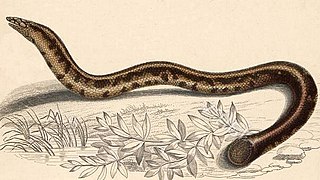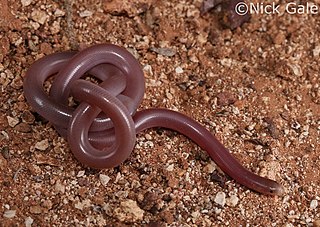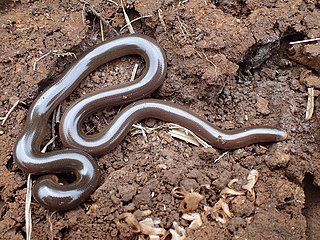
The Typhlopidae are a family of blind snakes. They are found mostly in the tropical regions of Africa, Asia, the Americas, and all mainland Australia and various islands. The rostral scale overhangs the mouth to form a shovel-like burrowing structure. They live underground in burrows, and since they have no use for vision, their eyes are mostly vestigial. They have light-detecting black eye spots, and teeth occur in the upper jaw. Typhlopids do not have dislocatable lower jaw articulations restricting them to prey smaller than their oral aperture. The tail ends with a horn-like scale. Most of these species are oviparous. Currently, 18 genera are recognized containing over 200 species.

The Anomalepididae are a family of nonvenomous snakes, native to Central and South America. They are similar to Typhlopidae, except that some species possess a single tooth in the lower jaw. Currently, four genera and 15 species are recognized. Common names include primitive blind snake and dawn blind snake.

The Leptotyphlopidae are a family of snakes found in North America, South America, Africa and Asia. All are fossorial and adapted to burrowing, feeding on ants and termites. Two subfamilies are recognized.

Indotyphlops braminus, commonly known as the brahminy blind snake and other names, is a non-venomous blind snake species found mostly in Africa and Asia, but has been introduced in many other parts of the world. They are completely fossorial animals, with habits and appearance similar to earthworms, for which they are often mistaken, although close examination reveals tiny scales rather than the annular segments characteristic of true earthworms. The species is parthenogenetic and all known specimens have been female. The specific name is a Latinized form of the word Brahmin. No subspecies are currently recognized.

Rhinophis saffragamus, the large shield tail snake, is a species of snake in the family Uropeltidae, which is endemic to the island of Sri Lanka. No subspecies are currently recognized.
The Palau Island blind snake is a species of snake in the Typhlopidae family.
The arboreal blind snake is a species of snake in the Typhlopidae family. The ramphotyphlops angusticeps is a snake native to the Solomon Islands.
Anilios australis, or the southern blind snake, is a species of snake in the family Typhlopidae. The species is endemic to Australia.

The prong-snouted blind snake is a species of non-venomous worm-like burrowing snakes belonging to the Typhlopidae family. It is endemic to central southern, continental Australia.

Anilios endoterus is commonly known as the interior blind snake. It is one of 42 species of snake in the genus Anilios (Ramphotyphlops) from the Typhlopidae family living in Australia. These snakes appear to be blind, having vestigial eyes that are extremely sensitive to light. It is a cryptic burrowing snake that lives in tunnels underground, living mainly on a diet of ants. They are found in arid and semi-arid desert regions of central Australia and are considered endangered in New South Wales (NSW).
The yellow-bellied blind snake is a species of snake in the Typhlopidae family.
The white-tailed blind snake is a species of snake in the Typhlopidae family.
The striped blind snake is a species of snake in the Typhlopidae family. Once claimed as being extinct, it was rediscovered in the Bukit Timah Nature Reserve in Singapore after 172 years. The snake was found dead, and it was 4 cm longer than the previous maximum limit of the snake's length, 48 cm.
The buff-snouted blind snake is a species of snake in the family Typhlopidae. The species is endemic to Australia.
The blackish blind snake is a species of snake in the Typhlopidae family native to south-eastern Australia.
The olive blind snake is a species of snake in the Typhlopidae family.
The Proximus blind snake or the woodland blind snake is a species of snake in the Typhlopidae family that is native to eastern Australia.
The brown-snouted blind snake, also known commonly as Wied's blind snake, is a species of snake in the family Typhlopidae. The species is endemic to Australia.
The Loyalty Islands blind snake is a species of snake in the family Typhlopidae. The species is endemic to Melanesia.

Bibron's blind snake is a species of snake in the family Typhlopidae. The species is native to southern Africa.







